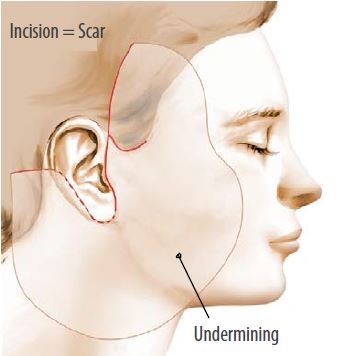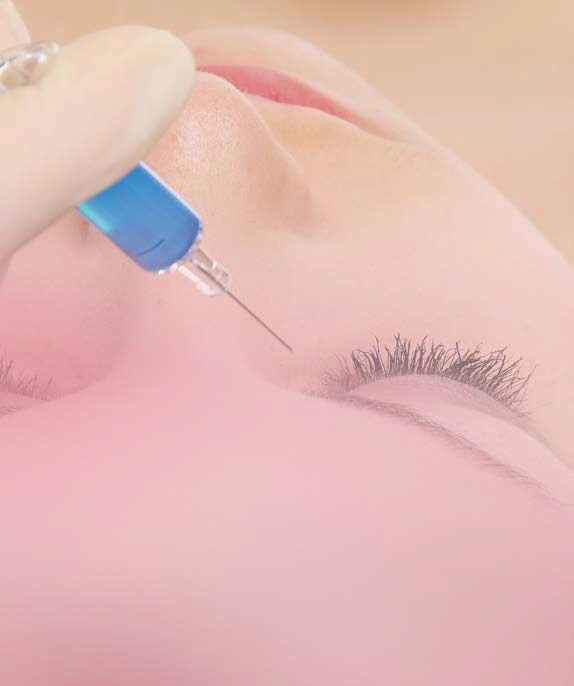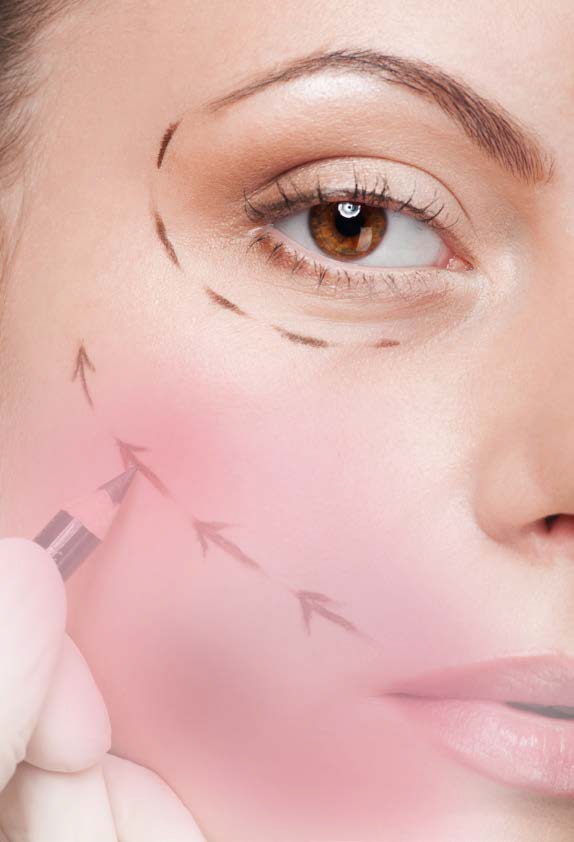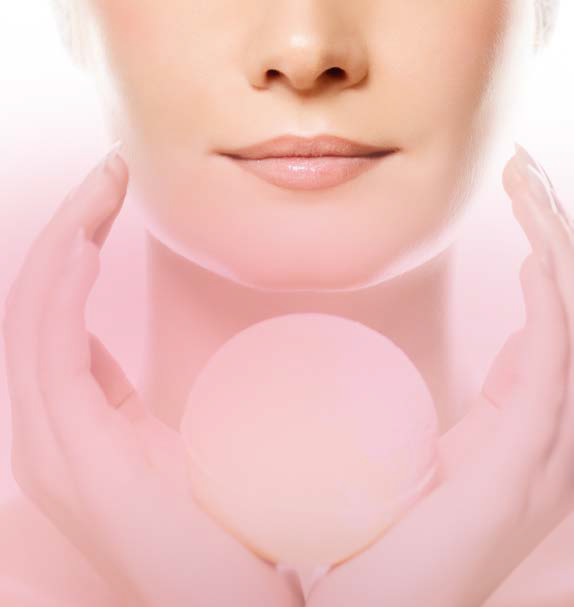This document has been conceived under the authority of the French Society of Plastic Reconstructive and Aesthetic surgery (Société Française de Chirurgie Plastique Reconstructrice et Esthétique – SOFCPRE) to complete the information that you received in your first consultation with your Plastic Surgeon. It aims to answer all the questions that you might ask, if you decide to undertake a face lift.
The aim of this document is to give you all the essential information you need in order to make an informed decision, with full knowledge of the facts related to this procedure. Consequently, we strongly advise you to read it carefully.
DEFINITION, AIMS AND PRINCIPLES
At present two types of face-lift make possible to remedy age-related unsightly aspects of the face and neck, either in one area or at a wider level.
The face- and neck-lift is the most frequent procedure; this means surgical correction of aging of the neck and also the face from the forehead to the jowls.
This cosmetic procedure is not reimbursed by health insurance.
Objectives
The aim of the operation is to remedy the sagging and laxity of the skin and muscles of the face(forehead, eyebrows, cheeks, jowls, and the oval facial outline) and the neck. The aim here is not only to transform the form and as-pect of the face. On the contrary, restoring the diferent anatomical structures of the face and neck (the skin, the muscles and the fat) enables the patient to look as he or she did some years earlier.
Principles
The muscles are tightened, to correct slackness. The skin is then draped as required over the new curves, without excessive stretching. This dual action gives a natural appearance (as the skin is not over-stretched), which lasts (since the muscular base is strong). The healing process is generally uneventful (the skin is less bruised because it is less traumatized, because the tension and separation are limited). Excess fat, if present can be treated by liposuction.
On the other hand, if the face appears emaciated, this can be corrected at the same time by re-injection of autologous fat. (liposculpture). In this way the face and the neck are <<rebuilt>> or <<restructured>>.
In contrast, expression lines, wrinkles of the crow’s feet or peri-oral wrinkles are not changed. The wrinkles are improved by the tension applied to the skin without ever completely disappear.
The aspect of the eyelids is not corrected by a face and neck lift isolated.
The incisions necessary for the procedure are hidden almost entirely in the hair (at the temples and the nape of the neck) and around the ears. The scar is thus almost entirely concealed
A face lift can be carried out as soon as signs of aging appear and the patient feels a real need for their correction, generally around the age of 40 or 45.
This procedure can be carried out at the same time as another facial cosmetic procedure : blepharoplasty (for the eyelids), forehead lift (endoscopic forehead lift). It can be completed by other treatment: (laserabrasion, dermabrasion, chemical peels, medical treatment of wrinkles.
BEFORE THE OPERATION
Prior to the operation a thorough examination will be carried out as prescribed.
You will see an anesthesiologist in consultation at the latest 48 hours before the procedure.
No aspirin-based medication should be taken over the 10 days preceeding the operation.
Stopping smoking is strongly recommended at least one month before and one month after the intervention (smoking can cause a delayed healing).
You must wash your hair the day before the operation and make-up must be thoroughly removed.
You must fast (neither eat nor drink) for 6 hours before the operation.
HOSPITAL STAY AND TYPE OF ANESTHESIA
Type of anesthesia: A face-lift can be carried out under general anesthesiaorlocal anesthesia with sedation (‘twilight’ anesthesia).
The type of anesthesia will be chosen after discussion between yourself, the surgeon and the anesthesiologist.
Hospital stayA 24-48 hour hospital stay is usual
THE PROCEDURE
Each surgeon has adopted his or her own specific technique which he or she adapts in order to obtain the best results in each case.We can however give some basic points:
The incision is almost completely hidden in the hair, or around the ears.
Once these incisions are made, the skin is detached to a greater or lesser extent in each case, according to the degree of sagging of the skin.
The muscle layer is then carefully and precisely tightened to correct laxity, without affecting the normal expression of the face.
If there are localized fat deposits, which can form on the neck, the chin, the jowls or the cheeks, lipoaspiration is performed during the operation.
The skin is then re-draped in a natural manner, excess skin removed, and stitches placed without excess tension.
Finally a dressing is placed around the head, framing the face.
The procedure lasts from two to three hours depending on the surgeon and the individual corrections required
AFTER THE OPERATION : POST – OPERATIVE EFFECTS
You will be able to go home on the first or second day after the operation.
For the first few days you are advised to rest and avoid physical strain.
During this period you should not be surprised by, or worried by the following:
- Edema (swelling) which can be worse on the second day than the first
- Bruising around the neck and chin
- A sensation of painful tightness especially behind the ears, and around the neck.
This bruising and swelling generally disappears in the two weeks following surgery.
After one month all signs of swelling have usually practically disappeared. The zones from which the skin was detached may feel slightly hardened, this is perceptible to the touch, but not visible. The ears will not regain normal sensitivity for one or two months.
Sometimes, you can observe for several weeks after the surgery, discomfort, tension on the tissues, an uncomfortable feeling of weight that can last for several weeks or months.
The scars are hidden by the hair both in front and at the back of the head. The only zone where they are visible, in front of the ears, can be temporarily masked by make-up or concealed by the hair.
So, we can say that you are presentable :
- On the seventh day for close friends and family
- On the twelfth day for friends
- After three weeks for people uninformed about the operation.
THE RESULT
After two or three months one can have a good idea of the final result. The scars, however will still be slightly pink and hard to the touch, and will not fade until the sixth month after the operation.
Through progress over the years and techniques of great precision we usually achieve a result giving an impression of considerable rejuvenation which nevertheless looks quite natural. The face does not have a ‘surgical’ appearance and has regained the features which it had eight to twelve years before. The general impression is relaxed and refreshed.
In general this physical improvement is also psychological.
The goal of this surgery is to make an improvement and not to achieve perfection. If your wishes are realistic, the result should give you great satisfaction
In the long term, a face-neck-lift has beaten the ravages of time, but aging does continue, and a second similar procedure can be envisaged after about ten years.
Disappointing result
These can be essentially:
- Edema (swelling) which can persist in certain zones three months after the procedure, and which needs to be treated by massage.
- A partial relapse of sagging skin (ptosis) particularly of the neck, when this was a major problem before surgery.
- Visible scars, or hair loss around the temples (alopecia) which can require revision surgery after six months to a year.
Possible complications
A face lift, although essentially an aesthetic procedure, is nevertheless an operation, and this implies that the risks inherent to any surgery apply here.
We must distinguish here between risks related to the anes-thesia and those related to the surgery.
- For the anesthesia, the risks will be explained by the anesthesiologist during the preoperative You must be aware that anesthesia can cause unpredictable reactions, which can be difficult to control : the presence of an experienced anesthesiologist, in a surgical context, means that the risks are statistically practically negligible.
In fact techniques, products and monitoring methods have progressed considerably over the last twenty years, giving optimal safety, especially when the operation is not an emergency and the patient is in good general health.
- Concerning surgery: by choosing a competent, qualified Plastic Surgeon, used to perform this procedure, you limit the risks, without however eliminating them completely.
Fortunately, real complications are rare following a face- and neck-lift which has been carried out correctly.
In fact practically all the operations go well and patients are completely satisfied with the result.
In spite of the fact that complications are so rare you must be aware of the following possible problems :
- A hematoma which must be rapidly drained.
- Skin death(necrosis) which delays the healing process.
- Infection which is extremely rare when the procedure is carried out in a sterile environment
- Nerve damage: in particular damage to a branch of the facial nerve which can lead to paresis, or facial paralysis. This is rare and the after-effects usually disappear in a few months.
- Abnormal scars, either hypertrophic or keloidal: they are impossible to foresee, and their development is unpredictable. They can threaten the aesthetic result and require specific local treatment over a long period.
All things considered, the risks must not be overestimated, but you must be conscious that an operation, even a minor one, always has some degree of unforeseeable unknown factors.
You can be assured that if you are operated on by a qualified Plastic Surgeon, he will have the experience and skill required to avoid these complications, or to treat them successfully if necessary.
Tell us what you think.
These booklets are regularly reviewed.
We welcome any suggestions to help us improve this booklet. You should send these to : Patient and Family Eduacation Commitee, Fv Hospital, 06 Nguyen Luong Bang Street, Saigon South (Phu My Hung), District 7, Ho Chi Minh City, Vietnam
E-mail: patient.education@fvhospital.com



